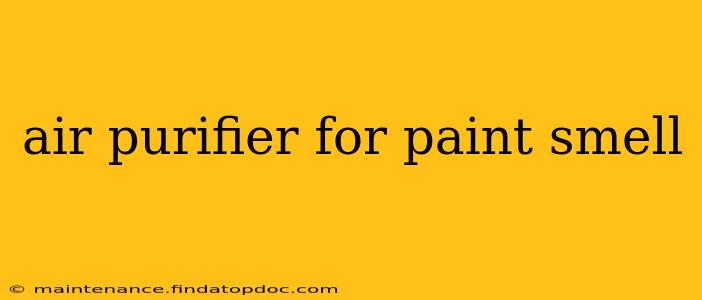The pungent smell of fresh paint can linger long after your home improvement project is complete. Volatile Organic Compounds (VOCs), released during the drying process, are the culprits. While opening windows and doors helps, an air purifier can significantly accelerate the process of removing paint fumes and improving your indoor air quality. But choosing the right one can be tricky. This guide will help you navigate the options and select the best air purifier for paint smell.
What Makes an Air Purifier Effective Against Paint Smell?
The effectiveness of an air purifier against paint smell hinges on two key factors: Clean Air Delivery Rate (CADR) and filtration technology.
-
CADR: This rating indicates how much clean air the purifier can produce per minute. A higher CADR means faster air purification. For effectively tackling paint fumes in a larger room, a higher CADR is crucial. Look for models with high CADR ratings specifically for VOCs and chemicals.
-
Filtration Technology: While HEPA filters are excellent at trapping dust and pollen, they may not be sufficient alone for eliminating paint VOCs. You'll need a purifier with activated carbon filters. These filters are specifically designed to adsorb odor molecules, including those released by paint. Some high-end models combine HEPA filters with activated carbon filters for a comprehensive approach.
What Type of Air Purifier is Best for Paint Smell?
Several types of air purifiers can handle paint odors. The best choice depends on your room size and budget.
-
HEPA Filter with Activated Carbon: This combination is the most effective for removing both paint particles and odor. The HEPA filter captures microscopic particles, while the activated carbon filter absorbs the VOCs.
-
Ozone Generators: While some people consider ozone generators, they're generally not recommended. Ozone is a harmful pollutant that can irritate your respiratory system. It's far better to use a purifier with HEPA and activated carbon filtration.
How Long Does it Take an Air Purifier to Remove Paint Smell?
The time it takes to eliminate paint smell depends on several factors:
- Room size: Larger rooms take longer to purify.
- Amount of paint used: More paint means more VOCs to remove.
- Type of paint: Some paints release more VOCs than others (low-VOC or zero-VOC paints release fewer).
- Air purifier CADR: A higher CADR means faster purification.
- Ventilation: Opening windows and doors can significantly speed up the process.
Generally, expect the process to take several hours to a few days. Continuous use of a high-CADR air purifier will significantly reduce the time.
What are the Best Air Purifiers for Removing Paint Fumes? (Note: We do not endorse specific products. Research current models based on CADR and filter type.)
Choosing a specific brand depends on your budget and room size. Focus your research on models with high CADR ratings, specifically for VOC removal, and ensure they include both HEPA and activated carbon filters. Check reviews to see real-world performance data.
Can an Air Purifier Completely Eliminate Paint Smell?
While an air purifier can significantly reduce and eliminate most of the paint smell, completely eliminating every trace might not always be possible. The persistence of the smell depends on the paint type, the amount used, and the thoroughness of ventilation. However, a good quality air purifier will get rid of the majority of the smell, making your space significantly more comfortable.
How Often Should I Change the Filters in My Air Purifier?
Filter replacement frequency is crucial for maintaining the effectiveness of your air purifier. Consult the manufacturer's guidelines, but generally, you should replace activated carbon filters every 3-6 months and HEPA filters every 12-24 months, or sooner depending on usage and the level of air pollution. Replacing filters is essential for maintaining the purifier's VOC removal capabilities.
Are There Any Other Ways to Reduce Paint Smell?
Besides using an air purifier, consider these additional strategies:
- Ventilation: Open windows and doors to increase airflow.
- Fans: Use fans to circulate air and speed up the drying process.
- Low-VOC or Zero-VOC Paints: Opt for paints with lower VOC content for future projects.
- Baking Soda: Place open containers of baking soda around the room to absorb odors.
- Activated Carbon Bags: Similar to baking soda, activated carbon bags can also help absorb odors.
By combining an effective air purifier with good ventilation and other odor-reducing techniques, you can quickly and efficiently eliminate the unpleasant smell of paint and restore a comfortable atmosphere in your home. Remember to research current models carefully to select the best air purifier for your specific needs.
